![]()
![]()
![]()
Use LEFT and RIGHT arrow keys to navigate between flashcards;
Use UP and DOWN arrow keys to flip the card;
H to show hint;
A reads text to speech;
52 Cards in this Set
- Front
- Back
|
MTOW
|
53,000lbs
|
|
|
Max Landing Weight
|
47,000 lbs
|
|
|
Maximum Zero Fuel Weight
|
44,000 lbs
|
|
|
Cargo Compartment Weight
|
Cargo compartment loading is limited to 3,500 lbs
|
|
|
Maximum airport pressure altitude for takeoff and landing is
|
10,000Ft
|
|
|
Maximum operating altitude is
|
41,000
|
|
|
Maximum ambient air temperature approved for takeoff and landing
is |
ISA +35 DEG C
|
|
|
Minimum ambient temperature approved for takeoff is
|
-40°C
|
|
|
Takeoff
Rotation Rate and Pitch Attitude |
WARNING
: Excessive rotation rates (exceeding 3 degrees per second) or over-rotations may lead to high pitch attitudes and angles of attack being attained while the aircraft is near the ground. This can reduce stall margins significantly resulting in stick shaker/pusher activation and potentially loss of control. Pilots must rotate smoothly towards the target pitch attitude then transition to speed control |
|
|
Pitch Trim
|
WARNING
: Failure to set the pitch trim appropriate to the computed center of gravity may result in excessive rotation rate at takeoff |
|
|
Operation in Icing Conditions
|
Cowl Anti-Ice System
1. Ground Operations: • The cowl anti-ice system must be ON when the OAT is 10°C or below and visible moisture in any form is present (such as fog with visibility of one mile or less, rain, snow, sleet and ice crystals). • The cowl anti-ice system must also be ON when the OAT is 10°C or below when operating on runways, ramps or taxiways where surface snow, ice, standing water, or slush is present. • When the cowl and wing anti-ice systems are selected ON, the L (R) COWL A/ICE caution message(s) may be posted, indicating a low pressure condition. The message(s) should disappear when engine thrust is increased. If more than 78% N2 is required to extinguish the messages, Maintenance action is required. If the L (R) COWL A/ICE caution message(s)appear without selecting the winganti-ice system ON, Maintenance action is required. 2. Flight Operations: • Icing conditions exist in- flight at a TAT of 10°C or below, and visible moisture in any form |
|
|
Aborted Takeoff
|
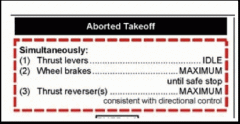
|
|
|
Double Engine Failure
|

|
|
|
CABIN ALT Msg or
Emergency Descent Procedure |

|
|
|
Stabilizer Trim Runaway
|
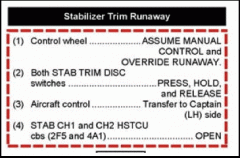
|
|
|
During Landing-
Excessive Asymmetry or loss of Braking |
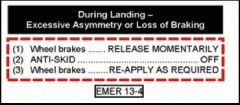
|
|
|
Configuration Warning
|

|
|
|
Max ramp weight
|
53,250 Lbs
|
|
|
HOT START
|
(1) Affected thrust lever…................................ SHUT OFF
(2) IGNITION…………………….................. OFF (3) Dry motor ................. ACCOMPLISH until ITT is reduced below 120°C or starter time limit, whichever comes first. |
|
|
INTERRUPTED START
|
(1) Affected thrust lever….. ............................ SHUT OFF
(2) IGNITION………………............. OFF (3) Dry motor until ITT is reduced below 120°C, respecting starter time limit |
|
|
NO LIGHTOFF
|
(1) Affected thrust lever ................................... SHUT OFF
(2) IGNITION…………………………………. ...... OFF (3) Dry motor until starter time limit |
|
|
N2 STAGNATION
|
(1) Affected thrust lever….. ......................... SHUT OFF
(2) IGNITION……………………………. OFF (3) Dry motor until ITT is reduced below 120° C, respecting starter time limit. |
|
|
LOW IDLING
|
Affected eng……….. ...... DO NOT ADVANCE THRUST LEVER
above 70% N2 until N2 has stabilized Within normal limits. |
|
|
NO STARTER CUTOUT Msg
|
Affected ENG STOP………………… ................... PRESS
|
|
|
Wing Anti-Ice System
|
1. Ground Operations
• Icing conditions exist on the ground when the OAT is 5°C or below and: – visible moisture in any form (such as clouds, fog or mist), is present below 400 feet AGL, or – the runway is wet or contaminated, or – in the presence of any precipitation (such as rain, snow, sleet or ice crystals). • The wing anti-ice system must be selected ON during final taxi prior to takeoff if the OAT is 5°C or below (regardless of weather conditions) , unless Type II, Type III or Type IV anti-icing fluids have been applied. During single engine taxi operations, final taxi prior to takeoff is defined as that period after the second engine is started. – L or R WING A/ICE caution messages may be posted during taxi but must be verified out and WING A/ICE ON advisory message posted, prior to takeoff. If wing anti-ice is not required for takeoff, it should be selected OFF just prior to takeoff. • To prevent wing contamination from reverse jet blast, operating the thrust reversers during taxi operations on wet and contaminated surfaces should be avoided. • The wing anti-ice system must be selected and con firmed ON for takeoff, when the OAT is 5°C or below and: – visible moisture in any form (such as clouds, fog or mist), is present below 400 feet AGL, or – the runway is wet or contaminated, or – in the presence of any precipitation (such as rain, snow, sleet or ice crystals). • If the wing anti-ice system is selected ON for takeoff, the cowl anti-ice system must also be selected ON. • When Type II, Type III or Type IV anti-icing fluids have been applied, the wing anti-ice system must only be selected and con firmed ON just prior to thrust increase for takeoff. • Refer to Vol. I, 5-2 – Takeoff. 2. Flight Operations: • Icing conditions exist in- flight at a TAT of 10°C or below, and visible moisture in any form is encountered (such as clouds, rain, snow, sleet or ice crystals), except when the SAT is -40°C or below. • The wing anti-ice system must be ON: – When ICE is annunciated by the ice detection system, or – When in icing conditions and the airspeed is less than 230 KIAS |
|
|
Super-Cooled Large Droplet Icing
|
• Continued operation in areas where SLD icing conditions exist is
prohibited. • SLD icing conditions are indicated by ice accretion on the flight compartment side windows. • The wing anti-icing system must be ON in SLD icing conditions. • The cowl anti-icing system must be ON in SLD icing conditions. • Leave icing conditions when side window icing occurs |
|
|
Cold Weather Operations
|
Takeoff is prohibited with frost, ice, snow or slush adhering to any critical
surface, (wings, upper fuselage, horizontal stabilizer, vertical stabilizer, control surfaces, an d engine inlets). WARNING : Even small amounts of frost, ice, snow or slush on the wing leading edges and forward upper wing surface may adversely change the stall speeds, stall characteristics and the protection provided by the stall protection system, which may result in loss of control on takeoff. Exception: Takeoff is permitted with frost adhering to: • the upper surface of the fuselage, if it is possible to distinguish surface features (markings and lines); frost in excess of this must be removed from the fuselage • the underside of the wing fuel tank area, that is caused by cold soaked fuel. Maximum 3mm (1/8 inch) layer of frost In addition to a visual check, a tactile check of the wing leading edge, wing forward upper surface, and wing rear upper surface is required during the external walkaround inspection to determine that the wing is free from frost, ice, snow or slush when: •the OAT is 10°C or less; or • the wing fuel temperature is 0°C or less; or • the atmospheric conditions have been conducive to frost formation. Ice and frost may continue to adhere to wing surfaces for some time even at outside air temperatures above 10°C |
|
|
Enhanced Takeoff Procedures and Winter Operations
Training |
No takeoff shall be conducted where the OAT is 5°C or below, unless the
PIC has successfully completed specific training, within the preceding 12 calendar months, for takeoff procedures, ground icing conditions, and cold weather operations. No takeoff shall be conducted by a pilot where the OAT is 5°C or below, unless that pilot has successfully completed specific training, within the preceding 12 calendar months, for takeoff procedures, ground icing conditions, and cold weather operations. If neither of the preceding requirements has been complied with, the wing anti-ice system must be selected on for takeoff, just prior to thrust increase for takeoff, if the OAT is 5°C or below |
|
|
Runway Slopes
|
The maximum runway slopes approved for takeoff and landing are:
• +2% (up hill) • -2% (down hill |
|
|
Tailwind Conditions
|
The maximum tailwind component approved for takeoff and landing is
10 kts |
|
|
Minimum Flight Crew
|
The minimum
flight crew is one pilot and one copilot. |
|
|
Engine Indications
|
RED – Maximum & minimum limitations
AMBER – Caution range GREEN – Normal operating range |
|
|
Engine Stabilization
|
•Prior to Takeoff: Engines must be running at least two minutes prior to
takeoff. •Prior to Shutdown : Operate the engines at IDLE for a minimum of two minutes to dissipate heat and stabilize internal operating temperatures. Taxi time at 80% N2 or below may be included in the two minute cool down period. |
|
|
Aircraft Cold Soak
|
Before the first flight of the day, when the aircraft is cold soaked at an ambient temperature of -30°C or below for more than eight hours, the
engines must be motored for 60 seconds and fan rotation must be verified before start is initiated. Thrust reversers must be actuated until the deploy and stow cycles are less than five seconds. |
|
|
Continuous Engine Ignition
|
Must be used during the following:
• Takeoff and landing on contaminated runways. • Takeoff with high crosswind components (greater than 10 kts.). • Flight through moderate or heavier intensity rain. • Flight through moderate or heavier intensity turbulence. • Flight in the vicinity of thunderstorms. • Engine operation at or near shaker and pusher settings is predicated on an operable auto-ignition system |
|
|
Starter Cranking Limits (Ground and Air)
|
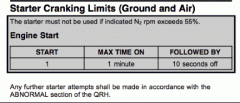
|
|
|
Associated Conditions
|
At initiation of thrust lever movement from SHUT OFF to IDLE:
• ITT must be 120°C or less for all ground starts |
|
|
Reduced Thrust
|
In determining the assumed temperature, when the reduced engine thrust
takeoff procedure is used, the takeoff performance data for APR OFF must always be utilized. • Reduced thrust can not be used if the normal takeoff fan speed is less than 85% N1 • If reduced thrust can be used, the fan speed for the reduced engine thrust must not be lower than 85% N1 The reduced engine thrust takeoff procedure must not be used: • If the wing and/or cowl anti-icing bleeds are in use. • On runways contaminated with standing water, slush, snow or ice. • When warnings of windshear or downdrafts have been forecast. • When using temperature from an approved nearby airport. For the actual temperature, use the current surface weather, do not use indicated SAT from the EFIS. This information is not valid on the ground. The reduced engine thrust procedure may be used on wet runways, provided that wet runway performance data is used |
|
|
Fuel
|
The maximum permissible fuel imbalance between the contents of the
main left tank and the main right tank is 800 lbs. Fuel remaining in a tank when the appropriate fuel quantity indicator reads zero is not usable. |
|
|
FUEL
|
Takeoff with fuel loads in excess of 500 lbs. in the center tank is not
permitted unless: • Each wing tank is above 4,400 lbs., or |
|
|
FUEL
|
The minimum fuel quantity for a go around is 450 lbs. per wing (with the aircraft level) and assuming a maximum aircraft climb attitude of 10°
nose up |
|
|
Design Maneuvering Speed
|

|
|
|
Flaps Extended Speed
VFO and VFE |
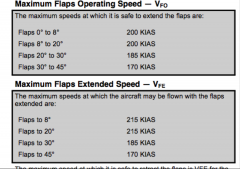
|
|
|
Gear Speeds
Operating and Extended |
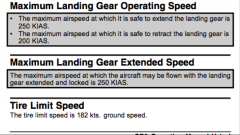
|
|
|
Turbulence Penetration Speed
|
Maximum airspeed for turbulence penetration is 280 KIAS or 0.75 Mach,
whichever is lower |
|
|
Minimum Operating Limit Speed
|
Intentional speed reduction below the onset of stall warning, as defined by
stick shaker operation, is prohibited unless a lower speed is specifically authorized for flight test or training operations |
|
|
Windshield Operating Speed Limit
|
The windshield wiper must not be operated above 220 KIAS
|
|
|
Wind Limitations
|
Do not attempt to takeoff or land with wind speeds in excess of 60 kts.
or a headwind component that exceeds 55 kts. |
|
|
Crosswind Limitations
|
The maximum demonstrated crosswind component for takeoff and
landing on a dry runway is 27 kts., however, the following are limitations: Wet Runway..........................................................27 kts. Contaminated runways with braking action less than good .............15 kts. Captain has less than 100 hours PIC in type (CR2) ........................27 kts |
|
|
DELAY BETWEEN CRANKING ATTEMPTS
|
A two minute delay should be observed between cranking attempts to
allow for cooling of starter and start contactor and for APU drainage. |
|
|
Start
Battery and Ground Power |
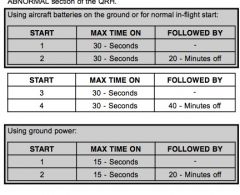
|
|
|
Flaps extended speed
|

|

